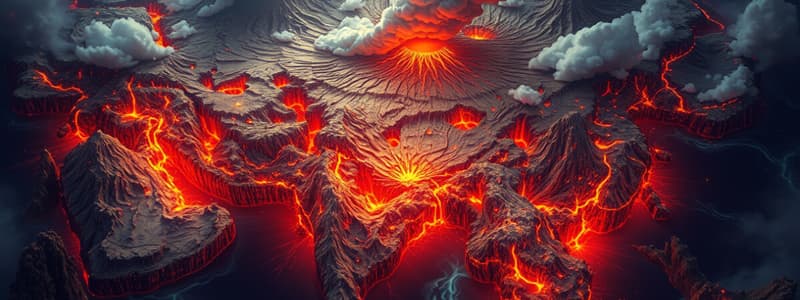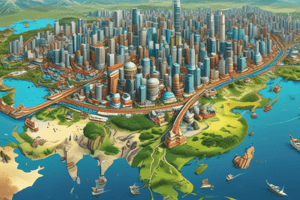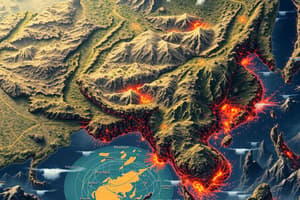Podcast
Questions and Answers
Asia is the world's largest continent, both in terms of land area and ______.
Asia is the world's largest continent, both in terms of land area and ______.
population
Most of Asia's population resides in ______ and India.
Most of Asia's population resides in ______ and India.
China
The movement of tectonic plates has affected Asia's volcanic activities and shaped its massive ______.
The movement of tectonic plates has affected Asia's volcanic activities and shaped its massive ______.
mountains
Most active volcanoes are located in the ______ Ocean.
Most active volcanoes are located in the ______ Ocean.
Asia extends from 10°S to ______ latitude.
Asia extends from 10°S to ______ latitude.
Asia is bounded by the Arctic Ocean in the north, the Pacific Ocean in the east, and the ______ Ocean in the south.
Asia is bounded by the Arctic Ocean in the north, the Pacific Ocean in the east, and the ______ Ocean in the south.
Asia has ______ sovereign states.
Asia has ______ sovereign states.
The Isthmus of Suez unites Asia with ______.
The Isthmus of Suez unites Asia with ______.
East Asia includes countries such as China, Mongolia, North Korea, South Korea, Japan, and ______.
East Asia includes countries such as China, Mongolia, North Korea, South Korea, Japan, and ______.
The region known as ______ extends from the Caspian Sea in the west to the border of western China in the east.
The region known as ______ extends from the Caspian Sea in the west to the border of western China in the east.
Countries including Afghanistan, Bangladesh, Bhutan, and ______ make up South Asia.
Countries including Afghanistan, Bangladesh, Bhutan, and ______ make up South Asia.
The ______ Range is known as the world’s highest mountain range.
The ______ Range is known as the world’s highest mountain range.
The highest peak in the Hindu Kush Mountains is ______.
The highest peak in the Hindu Kush Mountains is ______.
The ______ Mountain range is located in Gilgit-Baltistan and is home to several peaks over 8,000 metres.
The ______ Mountain range is located in Gilgit-Baltistan and is home to several peaks over 8,000 metres.
The longest mountain chain in Asia, extending across western China, is the ______ Mountains.
The longest mountain chain in Asia, extending across western China, is the ______ Mountains.
Victory Peak, at 7,439 metres, is the highest peak in the ______ Shan mountains.
Victory Peak, at 7,439 metres, is the highest peak in the ______ Shan mountains.
The highest point in the Zagros Mountains is ______, which stands at 4,409 metres.
The highest point in the Zagros Mountains is ______, which stands at 4,409 metres.
Lake Baikal, the oldest and deepest lake in the world, is located in the ______ Lowlands.
Lake Baikal, the oldest and deepest lake in the world, is located in the ______ Lowlands.
The ______ Plateau is known as the 'roof of the world' and is surrounded by mountain ranges.
The ______ Plateau is known as the 'roof of the world' and is surrounded by mountain ranges.
The ______ Basin and the Tsaidam Basin are great depressions found in the Central Highlands.
The ______ Basin and the Tsaidam Basin are great depressions found in the Central Highlands.
The Southern Plateaus include the Deccan Plateau, the Arabian Plateau, and the Shan and ______ Plateaus.
The Southern Plateaus include the Deccan Plateau, the Arabian Plateau, and the Shan and ______ Plateaus.
The Pamir Knot is a nodal point where several mountain ranges meet, including the Himalayas and the ______ Kush.
The Pamir Knot is a nodal point where several mountain ranges meet, including the Himalayas and the ______ Kush.
______ and the Asia-Pacific region of Russia are collectively referred to as North Asia.
______ and the Asia-Pacific region of Russia are collectively referred to as North Asia.
The Deccan Plateau is a large plateau in southern ______.
The Deccan Plateau is a large plateau in southern ______.
The Arabian Plateau gently slopes eastward towards the ______.
The Arabian Plateau gently slopes eastward towards the ______.
The ______ Plateau is crossed by the deep trench of the Salween River.
The ______ Plateau is crossed by the deep trench of the Salween River.
The Yunnan Plateau has mountain peaks rising above ______ metres.
The Yunnan Plateau has mountain peaks rising above ______ metres.
The Tigris-Euphrates Valley is formed by two rivers flowing through ______.
The Tigris-Euphrates Valley is formed by two rivers flowing through ______.
The Ganga-Brahmaputra Valley flows through India and ______.
The Ganga-Brahmaputra Valley flows through India and ______.
The Great Plain of China is formed by the Huang He, Chang Jiang and the ______ rivers.
The Great Plain of China is formed by the Huang He, Chang Jiang and the ______ rivers.
The Malay Archipelago is located between the Pacific Ocean and the ______.
The Malay Archipelago is located between the Pacific Ocean and the ______.
The Arabian Desert is the largest desert in ______.
The Arabian Desert is the largest desert in ______.
The Gobi Desert extends from northern China into ______.
The Gobi Desert extends from northern China into ______.
The Taklamakan Desert is primarily composed of shifting ______ dunes.
The Taklamakan Desert is primarily composed of shifting ______ dunes.
Lake Baikal is known as the deepest continental body of water at ______ feet.
Lake Baikal is known as the deepest continental body of water at ______ feet.
The Caspian Sea is considered the largest ______ on the planet.
The Caspian Sea is considered the largest ______ on the planet.
The Thar Desert primarily occupies the Indian state of ______.
The Thar Desert primarily occupies the Indian state of ______.
Flashcards are hidden until you start studying
Study Notes
Overview of Asia
- Asia is the largest continent by land area and population, covering 30% of the world's land and home to 60% of its population.
- Key populous countries include China (1.4 billion) and India (1.3 billion).
- Asia features diverse physical geography shaped by tectonic activities, comprising mountains, river plains, jungles, and modern cities.
Geographic Extent
- Spans from 10°S to 80°N latitude and 25°E to 170°W longitude.
- North-south distance: 8,560 km; east-west distance: 9,600 km.
- Bounded by various bodies of water: Arctic Ocean (north), Pacific Ocean (east), Indian Ocean (south), Middle Eastern seas (south-west), and Europe (west).
- Separated from North America by the Bering Strait and from Australia by straits linking the Indian and Pacific Oceans.
- The Isthmus of Suez connects Asia to Africa, with the Suez Canal marking the border.
Countries and Regions
- Comprises 49 sovereign states, six states with limited recognition, and six dependent territories.
Regional Divisions
- East Asia: Includes China, Mongolia, North and South Korea, Japan, Taiwan; covers about 28% of Asia.
- North Asia: Encompasses Siberia and the Asia-Pacific region of Russia.
- Central Asia: Extends from the Caspian Sea to western China, including former Soviet republics.
- South-East Asia: Contains countries like Indonesia, Thailand, and Vietnam.
- South Asia: Comprises Afghanistan, India, Pakistan, and others; the most densely populated region.
- West Asia: Comprises countries like Saudi Arabia, Iraq, and Turkey.
Physical Regions
- Northern Lowlands: World's largest continuous plain, spanning from Ural Mountains to Bering Sea, characterized by the Siberian Plain and Turan Plain, housing Lake Baikal.
- Central Highlands: Key mountain ranges converge at the Pamir Knot, including the Himalayas (highest), Hindu Kush, Karakoram, Kunlun, and Tien Shan.
- Southern Plateaus: Features the Deccan, Arabian, Shan, and Yunnan plateaus, primarily composed of hard crystalline rocks.
- Great River Basins: Fertile areas formed by major rivers like Tigris, Euphrates, Indus, and Ganga.
- Island Groups: Home to the Malay Archipelago and significant islands such as the Andaman and Nicobar Islands.
Mountains and Plateaus
- Himalayas: Home to the world’s highest peaks, including Mount Everest (8,848 m).
- Karakoram Range: Contains K2 (8,611 m), the second highest peak globally.
- Hindu Kush: Mount Tirich Mir stands at 7,690 m, marking the highest in this range.
- Tibetan Plateau: Known as the “roof of the world,” surrounded by multiple mountain ranges.
Deserts
- Arabian Desert: Largest in Asia, covering 2.33 million km².
- Gobi Desert: Second largest, spanning 1.295 million km² between China and Mongolia.
- Taklamakan Desert: China’s largest sand desert, covering 337,000 km².
- Thar Desert: Asia’s only subtropical desert, lies mainly in Rajasthan, India.
Water Bodies
- Caspian Sea: Largest lake globally, characterized by salty water.
- Lake Baikal: World’s deepest and oldest freshwater lake at 5,315 feet.
- Aral Sea: Rapidly shrinking due to pollution and mismanagement.
Cultural Diversity
- Asia is characterized by its rich cultural diversity, with a wide range of languages, traditions, and ethnic groups that reflect its vast geographical and historical complexity.
Studying That Suits You
Use AI to generate personalized quizzes and flashcards to suit your learning preferences.




